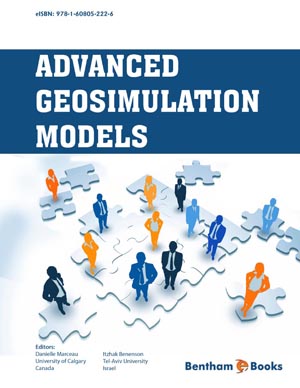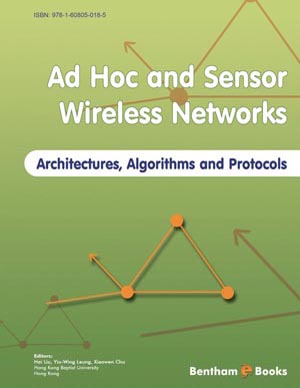Preface
Page: iv-iv (1)
Author: Danielle J. Marceau and Itzhak Benenson
DOI: 10.2174/9781608052226111010100iv
List of Contributors
Page: v-vii (3)
Author: Danielle J. Marceau and Itzhak Benenson
DOI: 10.2174/97816080522261110101000v
Challenges and Perspectives in Geosimulation
Page: 3-13 (11)
Author: Danielle J. Marceau and Itzhak Benenson
DOI: 10.2174/978160805222611101010003
PDF Price: $15
Abstract
Geosimulation is a rapidly growing field of scientific investigation that involves the use of objectbased spatially-explicit models in order to understand, through simulation, the dynamics of complex, adaptive human-driven geographic systems. Grown on cellular automata and multi-agent systems, it is progressively evolving towards an integrated framework in which physical objects of the environment and animated agents, especially humans, are investigated in interaction with each other. Simulating humans and other animated agents acting and interacting within an evolving environment raises conceptual and methodological challenges. The first one is the adequate representation of geographic space through meaningful spatially located objects. The implementation of objects' flexible geometry, neighborhood relations, rules of objects movement and relocation, all in 3D virtual space and at different scales are among the recent advances that we discuss in the paper. The second challenge is the validation of Geosimulation models. This paper presents several recent qualitative and quantitative techniques, including the pattern-oriented approach that aims at reproducing patterns that can be observed in reality. It is followed by an overview of the content of the book in respect to the concepts and methods that address these two challenges. We conclude that collaboration among researchers for sharing datasets and comparing models is a critical step towards the credibility and operability of Geosimulation models
Activity Based Variable Grid Cellular Automata for Urban and Regional Modelling
Page: 14-29 (16)
Author: Roger White, Harutyun Shahumyan and Inge Uljee
DOI: 10.2174/978160805222611101010014
PDF Price: $15
Abstract
Traditional cellular automata (CA) based models of land use change represent only local processes. Processes operating over longer distances are captured in traditional spatial interaction based models; these are then linked to the CA so that the linked models cover a range of scales. An alternative approach presented here includes processes operating at all scales within the CA model itself. This is done by increasing the size of the cell neighbourhood to include the entire modelled area, so that long range effects are included in the cellular transition functions. In order for this approach to be computationally reasonable, a variable grid is used, so that as the distance from the centre of a cell neighbourhood increases, the size of cells in the neighbourhood also increases, with cells of successive Moore rings, n, of a cell neighbourhood scaling as 3n from the basic raster cell size. Since all Moore rings but the smallest consist of composite cells, in general the state of neighbourhood cells must be characterized by a vector of activity levels, where each cell of the raster level is assigned a quantity of the activity corresponding to its land use (e.g. each residential cell is assigned a population). Tests of this approach show that it gives clearly better predictions of both land use patterns and regional activity levels (e.g. regional populations) when compared with conventional approaches. It is also “riskier” in the Popperian sense and thus more powerful as an explanatory tool.
Geographical Vector Agent-Based Simulation for Agricultural Land-Use Modelling
Page: 30-48 (19)
Author: Antoni Moore
DOI: 10.2174/978160805222611101010030
PDF Price: $15
Abstract
Spatial structures of anthropogenic origin tend to exhibit complex patterns made up of heterogeneous and irregular objects. While the urban structure is a typical example and has received a lot of attention, the agricultural domain can be included in this group of structures, also inheriting its attendant properties. Complex domains of this kind form a challenge to geosimulation techniques, notably cellular automata (CA). Like Geographic Automata Systems (GAS), Geographical Vector Agents (GVA) have been introduced as a vector geometry alternative to CA, which bases its operations on geographically unrealistic regular cells. Indeed, the geometric element of GAS has already had a GVA-based structure imposed on it, with irregular and dynamic GVAs in particular being explored. Given the irregular nature of both domain and technology, it is this type of GVA that is applied to the modelling of agricultural land use and is reported on in this chapter. A simple theoretical scenario was presented and evaluated, an attempt to parameterise GVA to model von Thünen’s theory of agricultural land use. GVA was found to handle well the irregular geometry and neighbourhood demands as well as the rules and states relating to this hypothetical agricultural scenario.
Advances and Techniques for Building 3D Agent-Based Models for Urban Systems
Page: 49-65 (17)
Author: Andrew T. Crooks, Andrew Hudson-Smith and Ateen Patel
DOI: 10.2174/978160805222611101010049
PDF Price: $15
Abstract
There is a growing interest in relating agent-based models to real-world locations by combining them with geographical information systems (GIS) which can be seen with the increase of geosimulation models in recent years. This coincides with the proliferation of digital data both in the two and three dimensions allowing one to construct detailed and extensive feature-rich and highly visual 3D city models. This chapter explores some of these developments in relation to our own initial work on building 3D geospatial agent-based models of urban systems and the technologies that allow for such models to be created. These range from coupling agent-based models with 3D visualization, to building 3D agent-based models in 3D animation and rendering packages, and to using 3D virtual worlds for the creation of agent-based models.
Semantically-Enhanced Virtual Geographic Environments for Multi-Agent Geo-Simulation
Page: 66-91 (26)
Author: Mehdi Mekni, Bernard Moulin and Sebastien Paris
DOI: 10.2174/978160805222611101010066
PDF Price: $15
Abstract
Multi-Agent Geo-Simulation (MAGS) is a modeling and simulation paradigm which aims to study various phenomena in a variety of domains involving a large number of heterogeneous actors (implemented as software agents) evolving in, and interacting with, a Virtual representation of the Geographic Environment (VGE). A critical step towards the development of advanced MAGSs is the creation of semantically-enhanced and geometrically accurate virtual geographic environments called Informed VGE (IVGE). In this chapter we propose a novel approach to automatically build an accurate IVGE using an exact decomposition of realistic spatial data provided by Geographic Information System (GIS). The IVGE model relies on a hierarchical topologic graph structure built using geometric, topologic, and semantic abstraction processes and enhanced by spatial semantic information represented using Conceptual Graphs (CGs). We demonstrate how we take advantage of the IVGE description in order to provide an accurate 2D/3D visualization tool of the space partitioning as well as to support situated reasoning such as path planning with respect to both agents and environments’ characteristics.
Empirical Calibration of Spatially Explicit Agent-Based Models
Page: 92-110 (19)
Author: Scott Heckbert and Ian Bishop
DOI: 10.2174/978160805222611101010092
PDF Price: $15
Abstract
Spatially explicit agent-based models integrate human and environmental systems and reveal patterns that arise from a multitude of individual decisions. Properly defining micro-scale behaviours therefore has large importance for macro outcomes, bringing model validation and calibration issues into focus as a challenge for the research community. This paper describes techniques to empirically calibrate representations of decision making processes in agent-based models. Examples are reviewed using survey data, participatory approaches with geovisualisation and experimental economics. Novel approaches are presented, including experimental economics directly integrated with a spatially explicit agent-based model to reveal trading behaviours in markets. The experimental economics calibration tool directly integrated with an agent-based model reduces the need for interpretation in subsequent use of participant data to re-calibrate artificial agents.
Geosimulation of Income-Based Urban Residential Patterns
Page: 111-125 (15)
Author: Erez Hatna and Itzhak Benenson
DOI: 10.2174/978160805222611101010111
PDF Price: $15
Abstract
Maps of high-resolution residential patterns of Israeli cities reveal essential spatial heterogeneity in relation to family income, a situation that was found in eight of the nine cities investigated. Modern urban theory provides several explanations of how homogeneous urban patterns self-organize and persist; however the mechanisms that allow the persistence of heterogeneous patterns remain unexplained. We argue that the observed residential heterogeneity can be explained on the basis of householders’ residential preferences and behavior. Namely, the householders differ in respect to their willingness to reside near poorer neighbors. Residential heterogeneity is the consequence of this variability.
In order to investigate this hypothesis, we developed an agent-based model of residential dynamics in the city, which extends the Schelling model of segregation. Model residential agents represent families, which differ in their economic abilities and their tolerance of poorer neighbors. Using the model, we demonstrate that quite a low fraction of tolerant agents is sufficient for the emergence and persistence of heterogeneous residential areas in the city. This result is robust to the uncertainty of our knowledge about the fraction of highly tolerant agents - the variation in this fraction only weakly influences the resulting urban heterogeneity. We thus conclude that the presence of residential agents who are tolerant of their poorer neighbors is sufficient to explain long-term urban heterogeneity and we discuss the possible consequences of this result for the theory of urban gentrification.
Open-Ended Agent-Based Economic Evolution
Page: 126-141 (16)
Author: Bas Straatman and Danielle J. Marceau
DOI: 10.2174/978160805222611101010126
PDF Price: $15
Abstract
Agent-based computational economics (ACE) is a recent development and adds to existing economic research by focusing on heterogeneous agents with bounded rationality who act upon incomplete information and who interact locally, instead of the uniform a-spatial fully rational homo economicus. The two approaches also differ in their aim. Traditional economics has its origins in equilibrium theory and aims for the stable state, while ACE focuses on the dynamics of the system and the processes that shape it. Instead of modelling to predict the outcome of the system, the focus is on the realism of the paths followed, and it is accepted that outcomes can vary. The ACE model presented in this chapter carries the idea of open-endedness a little further: not only are there multiple possible outcomes of the model, there is also an increase in complexity as the economy continues to produce novel forms (conform Standish's definition of open-endedness [1]). This exemplifies a general trend of complex systems: instead of returning to equilibrium, complex systems, such as the economy, increase their complexity, while novel elements are constantly introduced into the system. This novelty allows an increasingly complex organization of elements, processes and subsystems. To show that open-endedness can be modelled, this paper presents a model that incorporates open-endedness in the form of an agent-based artificial evolving economy. The model results show continuous expansion of the economy by novel products and technologies. This might very well be the first (economic) model to display this kind of evolutionary dynamics.
Index
Page: 142-145 (4)
Author: Danielle J. Marceau and Itzhak Benenson
DOI: 10.2174/978160805222611101010142
Introduction
Geosimulation has recently emerged at the intersection of Geographic Information Science, Complex Systems Theory and Computer Science. Geosimulation aims at understanding the dynamics of complex human-driven spatial systems through the use of spatially explicit computer simulation. The approaches and tools for validating Geosimulation models are especially important for understanding their complex and spatially heterogeneous outcomes. The Ebook presents the recent conceptual and methodological advances achieved in the field. It should be very useful for scientists and graduate students working in the fields of Complex Systems Modelling, Geocomputation, Science, Geography, Regional Science, Computer Science, Artificial Intelligence, Environment Simulation and Modeling, and Environmental Engineering.


















